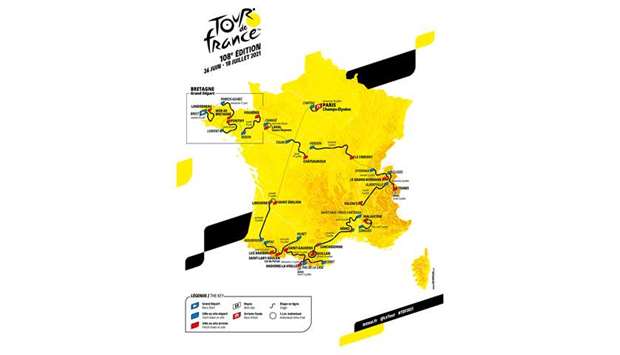Tour de France chiefs on Sunday unveiled the route for the 2021 edition, featuring two ascents of the iconic Mont Ventoux on the same day and a decisive penultimate day time trial through the Bordeaux vineyards.
The June 26 to July 18 three-week race starts with four days in Brittany, eventually culminating with a sprint along Paris’s famed Champs-Elysees.
In between, the race will sweep through the Loire Valley and into the Alps, continue to the south coast and Provence as a precursor to some epic climbing in the Pyrenees.
Then comes the showdown in the Bordeaux wine region before the formalities of Paris where Tadej Pogacar celebrated a shock triumph this year.
Traditionally unveiled in front of 4,000 people at a glittering ceremony, with most of the top cyclists and the mayors of the towns along the route, Covid-19 once again caused a rethink.
The unveiling event was a live TV reveal instead with race director Christian Prudhomme the master of ceremonies.
The route is a departure from the last two editions which featured little individual time-trialling.
Next year will have two of them, while old style long mountain ascents are back on the menu after the last two Tours featured many more shorter climbs.
Any rider with ambitions of winning the 2021 Tour will need to excel at time-trialling with a whopping 58km on the agenda.
They will also have to be able to survive the lung-busting long climbs.
Known as ‘the Giant of Provence’, Mont Ventoux, with its lunar landscape upper reaches, will have to be climbed twice on the same day, while the ski resort Tignes is also featured.
“It’s all there for the climbers too,” Prudhomme suggested, while France’s two top climb specialists were more wary.
“I’ll be there,” said Romain Bardet who described the route as traditional.
“But it doesn’t suit my preference for racking up big, tiring mountains,” he said.
“There’s less there than usual for the climbers but it’s an interesting course anyway,” said France’s popular contender Thibaut Pinot.
“We had to be pragmatic,” Prudhomme said of the return to old style tours.
“It’s hard to draw conclusions from last season even with the astonishing performances of some younger riders,” he said in reference to the then 21-year-old Pogacar winning this year and 25-year-old Tao Geoghegan Hart claiming the Giro d’Italia.
One aspect retained from the last two years is that the action is loaded to explode early, on stage two’s finish up the short steep climb called the Mur de Bretagne.
It’s where a rider such as French world champion Julian Alaphilippe has a perfect chance to grab the overall leader’s yellow jersey for a third year in a row.
“So we have tried to vary the thing to the maximum, there’s no dogma, but we went for maximum change, taking into account the switch from Copenhagen and all the coronavirus effects,” said Prudhomme, who sat out a week of the 2020 edition after testing positive for coronavirus.
The Tour starts a week early to avoid clashing with the Tokyo Olympics and had to hastily reorganise the start after the originally scheduled Copenhagen Grand Depart was cancelled to accommodate football’s European Championship.
“We needed a new Grand Depart and to make it a week earlier,” Prudhomme said of preparations he described as a race against the clock.
Of the June 26 start in Brest, course designer Thierry Gouvenou said getting permission to race had been tense.
In 2020, opposition to the Tour de France was voiced by Green Party mayors in Lyon and Rennes.
“There were (municipal) elections too and we had you wait, it was quite tense, we plotted a third of the course before the delayed 2020 race and then the rest afterwards.”

..


